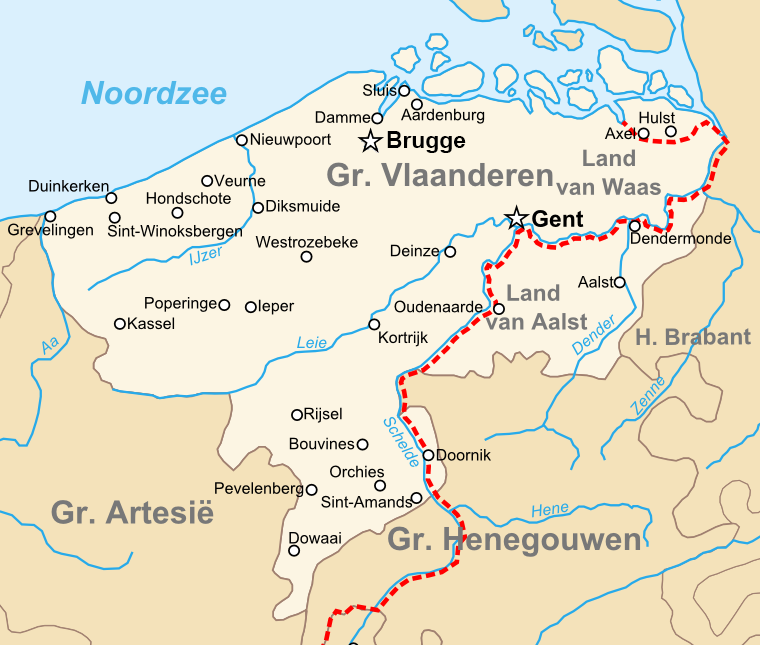| Region | Comment | Area | Lower End | | Upper End | | | Urbanization | |
| | | km² | people/km² | Population | people/km² | Population | Urban Pop | Lower | Upper |
| A | Northern Rheinland | Very fertile, includes Germany's biggest city, densely populated and urbanized | 7,297 | 28 | 204,315 | 56 | 408,631 | 100,000 | 49% | 24% |
| B | Southern Rheinland | Hilly, forested, includes Koblenz and Trier, but rural character in general | 17,410 | 13 | 226,326 | 26 | 452,651 | 28,000 | 12% | 6% |
| C | Fertile Ruhr | Fertile, urbanzied, on important trade route | 3,555 | 25 | 88,871 | 50 | 177,741 | 36,000 | 41% | 20% |
| D | Münsterland, Ostwestfalen, Osnabrück | Urbanized, but average fertility | 12,757 | 15 | 191,362 | 30 | 382,724 | 50,000 | 26% | 13% |
| E | Lower Saxony | Low fertility, low development on the coast, only trade cities are notable | 32,720 | 9 | 294,477 | 18 | 588,954 | 35,000 | 12% | 6% |
| F | Angria from Celle to Kassel | Urbanized, but average fertility, rich from Harz mining | 16,316 | 15 | 244,739 | 30 | 489,478 | 55,000 | 22% | 11% |
| G | Schleswig-Holstein, Hamburg | Not very developed or fertile, but some important trade cities | 17,651 | 9 | 158,859 | 18 | 317,718 | 45,000 | 28% | 14% |
| H | Mecklenburg, Pomerania, Neumark | Only the coastal cities are notable (and there are some sizeable ones), the hinterland is mostly undeveloped and not fertile | 60,617 | 7 | 424,322 | 14 | 848,643 | 43,000 | 10% | 5% |
| I | Brandenburg, Altmark, Lusatia | Relatively recently settled region, forested, not highly developed, nor urbanized | 40,475 | 8 | 323,797 | 16 | 647,594 | 37,000 | 11% | 6% |
| J | Saxony, Anhalt, Erfurt Basin | Highly fertile, urbanized, rich mining | 37,752 | 20 | 755,048 | 40 | 1,510,096 | 134,000 | 18% | 9% |
| K | Mittelgebirge | Hilly woodland, with a few smaller towns, not the most inviting land to settle | 32,915 | 11 | 362,070 | 22 | 724,141 | 37,000 | 10% | 5% |
| L | Rhein-Main | Urbanized, fertile land along the rivers, important for trade | 6,818 | 27 | 184,073 | 54 | 368,146 | 68,000 | 37% | 18% |
| M | Kraichgau, Neckar | Fertile and urbanized, used to be even more developed under the Staufer | 7,828 | 24 | 187,869 | 48 | 375,738 | 40,000 | 21% | 11% |
| N | Upper Rhine Valley | Fertile, but not very urbanized | 6,138 | 20 | 122,760 | 40 | 245,520 | 16,000 | 13% | 7% |
| O | Alsace | Includes the Vosges, but fertile along the Rhine | 8,911 | 19 | 169,317 | 38 | 338,634 | no data | | |
| P | Southern Swabia, Bavaria, Schwarzwald | Low fertility, agriculture focused on livestock | 30,257 | 12 | 363,088 | 24 | 726,176 | 17,000 | 5% | 2% |
| Q | Bavaria, Franconia | Includes important cities like Nuremberg or Augsburg, average fertility | 47,469 | 16 | 759,504 | 32 | 1,519,008 | 119,000 | 16% | 8% |
| R | Bavarian Forest, Upper Palatinate | Hilly and forested, but important mining | 16,793 | 11 | 184,723 | 22 | 369,446 | 9,000 | 5% | 2% |
| S | Northern Bohemia | Fertile, with rich mining and Prague | 25,082 | 22 | 551,801 | 44 | 1,103,602 | 39,000 | 7% | 4% |
| T | Southern Bohemia | Less fertile, less urbanized | 30,740 | 16 | 491,847 | 32 | 983,693 | 9,000 | 2% | 1% |
| U | Moravia | Fertile and relatively urbanized | 20,741 | 19 | 394,086 | 38 | 788,173 | 31,000 | 8% | 4% |
| V | Northern Austria | Some fertile land along the Danube, includes Vienna and much of Austria's population | 33,490 | 20 | 669,801 | 40 | 1,339,602 | 41,000 | 6% | 3% |
| W | Fertile Switzerland, Vorarlberg | Fertile Swiss Plateau, includes much of Switzerland's population | 16,592 | 16 | 265,474 | 32 | 530,948 | 57,000 | 21% | 11% |
| X | Alps | Mountainous, not a lot of land to settle, sparsely populated | 71,865 | 6 | 431,188 | 12 | 862,375 | 19,000 | 4% | 2% |










